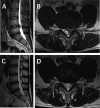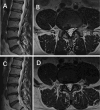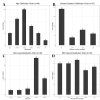Spontaneous regression of lumbar disc herniation: four cases report and review of the literature
- PMID: 39355368
- PMCID: PMC11439616
- DOI: 10.18999/nagjms.86.3.370
Spontaneous regression of lumbar disc herniation: four cases report and review of the literature
Abstract
Spontaneous regression of lumbar disc herniation refers to shrinkage or disappearance of herniated nucleus pulposus without invasive surgical treatments. This phenomenon has been reported and is supported by improved clinical symptoms and radiographic after conservative treatment, but the underlying mechanism remains unclear. This article reports 4 cases of disc reabsorption and reviews the distribution of several clinical and radiographic factors of disc herniation reabsorption of total 46 patients, including the four from our study, gathered from 28 recent publications. Some of these factors are present with anomalous distributions. But some factors have similar deviations in patients with lumbar disc herniation. Therefore, more research is needed to explore the correlation between those factors and disc reabsorption.
Keywords: clinical factor; lumbar disc herniation; radiographic factor; reabsorption; spontaneous regression.
Figures







Similar articles
-
Spontaneous regression of lumbar herniated disc.J Chin Med Assoc. 2009 Dec;72(12):650-3. doi: 10.1016/S1726-4901(09)70449-6. J Chin Med Assoc. 2009. PMID: 20028647
-
Spontaneous regression of a lumbar disc herniation: case report.Med Sci Monit. 2007 Oct;13(10):CS121-3. Med Sci Monit. 2007. PMID: 17901855
-
Spontaneous regression of posterior epidural migrated lumbar disc fragments: case series.Spine J. 2015 Jun 1;15(6):e57-62. doi: 10.1016/j.spinee.2013.07.430. Epub 2013 Sep 14. Spine J. 2015. PMID: 24041917
-
Spontaneous regression of herniated lumbar discs: Report of one illustrative case and review of the literature.Clin Neurol Neurosurg. 2016 Apr;143:86-9. doi: 10.1016/j.clineuro.2016.02.020. Epub 2016 Feb 16. Clin Neurol Neurosurg. 2016. PMID: 26907997 Review.
-
Spontaneous regression of a large sequestered lumbar disc herniation: a case report and literature review.J Int Med Res. 2021 Nov;49(11):3000605211058987. doi: 10.1177/03000605211058987. J Int Med Res. 2021. PMID: 34812080 Free PMC article. Review.
References
Publication types
MeSH terms
LinkOut - more resources
Full Text Sources
Medical
